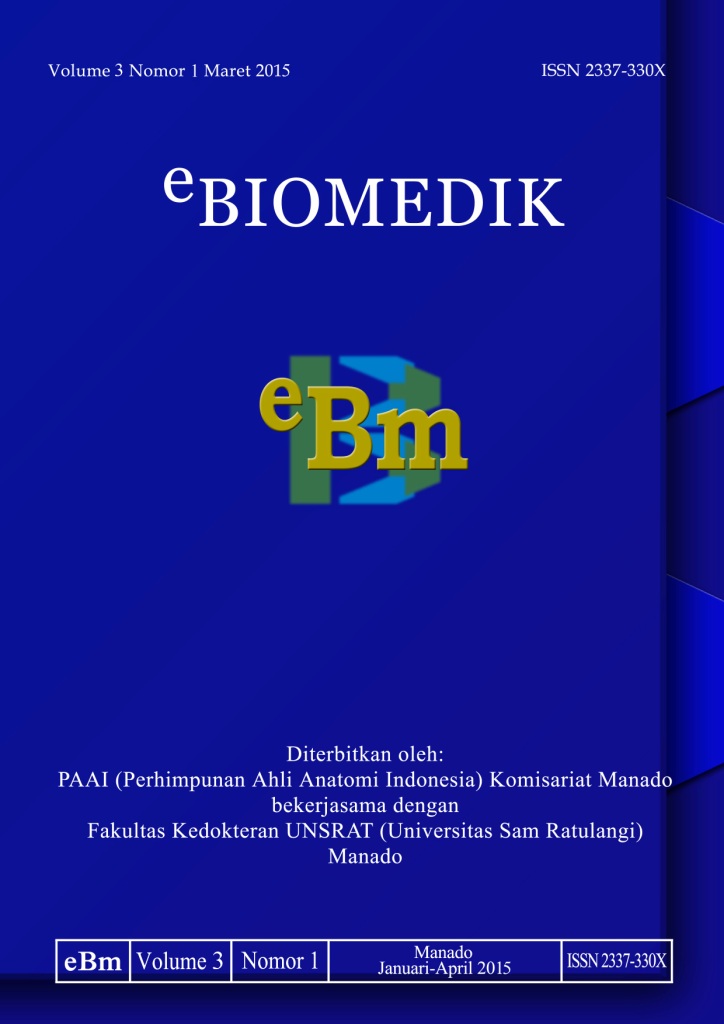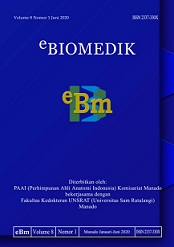UJI RESISTENSI BAKTERI ESCHERICHIA COLI YANG DIISOLASI DARI PLAK GIGI TERHADAP MERKURI DAN ANTIBIOTIK KLORAMFENIKOL
DOI:
https://doi.org/10.35790/ebm.v3i1.6607Abstract
Abstract: Mercury is a liquid element at room temperature. Some main effects of mercury are dysfunctional of brain, kidneys and lungs, tremor, anxiety or nervous, insomnia, fetal growth restriction, and liver damage in pregnancy. Dental plaque is a soft material that attach on tooth’s surface, dental filling, or calculus. Antibiotic is a chemical substance that has the ability to inhibit the growth and kill microorganisms. Chloramphenicol is a broad-spectrum antibiotic that useful for treatment of a number of bacterial infections and anaerobic bacteria. The research using descriptive method. Subject of the research was mercury resistence Escherichia coliwhich isolated from dental plaque with dental filling and grew at broth Luria Bertani (LB) and solid LB. The result of observation on bacteria after incubated at 370C for 24 hours showed that at HgCl2, with available dilution, found bacteria at dental plaque with higher amounts of growth at 10ÏÏm concentration, intermediate amount of growth at 20ÏÏm concentration, and less amount of growth at 40ÏÏm concentration. As the result of observation on Escherichia coli after 24 hours of incubation, researcher found that the inhibition zone diameter of Eschericia coli for 30μg chloramphenicol was 20mm (>12mm) during first, second, and third treatment and included in sensitive category. Conclusion: As the result of this research, the inhibition zone diameter of Eschericia coli for 30μg chloramphenicol was 20mm (>12mm) during first, second, and third treatments and included in sensitive category.
Keywords: mercury, dental plaque, chloramphenicol, Eschericia coli.
Abstrak: Merkuri adalah suatu unsur berbentuk cair keparatan dalam suhu kamar. Resiko utama merkuri adalah tidak berfungsinya otak, ginjal, tremor, rasa gelisah atau gugup, insomnia, gangguan fungsi paru-paru, memperlambat pertumbuhan janin, kerusakan liver pada kehamilan. Plak gigi adalah deposit lunak yang melekat pada permukaan gigi, tumpatan, maupun kalkulus. Antibiotik adalah zat kimia yang mempunyai kemampuan untuk menghambat pertumbuhan dan membunuh mikroorganisme. Kloramfenikol adalah antibiotik spektrum luas yang efektif terhadap beberapa jenis bakteri dan bakteri anaerob. Penelitian adalah metode deskriptif eksploratif. Sampel yang diambil dalam penelitian adalah bakteri Escherichia coli resistensi merkuri yang diisolasi dari plak gigi dengan tumpatan amalgam dan tumbuh pada media Luria Bertani (LB) broth dan media LB padat.Pengamatan setelah bakteri diinkubasi pada suhu 370C selama 24 jam didapatkan hasil bahwa pada HgCl2 dengan pengeceran yang ada, di dapatkan bakteri isolat yang diidentifikasi dari plak gigi dengan hasil pertumbuhan yang banyak terdapat pada konsentrasi 10ÏÏm, pertumbuhan sedang terdapat pada konsentrasi 20ÏÏm, dan pertumbuhan sedikit terdapat pada konsentrasi 40ÏÏm. Pengamatan setelah bakteri Escherichia coli diinkubasi selama 24 jam didapatkan bahwa diameter zona hambat Escherichia coli terhadap antibiotik kloramfenikol 30μg pada pengulangan pemberian I, II, dan III sebesar 20mm (>12mm) dan termasuk dalam kategori sensitif. Simpulan: Hasil uji yang tekah dilakukan didapatkan bahwa diameter zona hambat Escherichia coli terhadap antibiotik kloramfenikol 30μg pada pemberian I,II,dan III sebesar 20mm (>12mm) termasuk dalam kategori sensitif.
Kata kunci: merkuri, plak gigi, kloramfenikol, bakteri Echerichia coli





